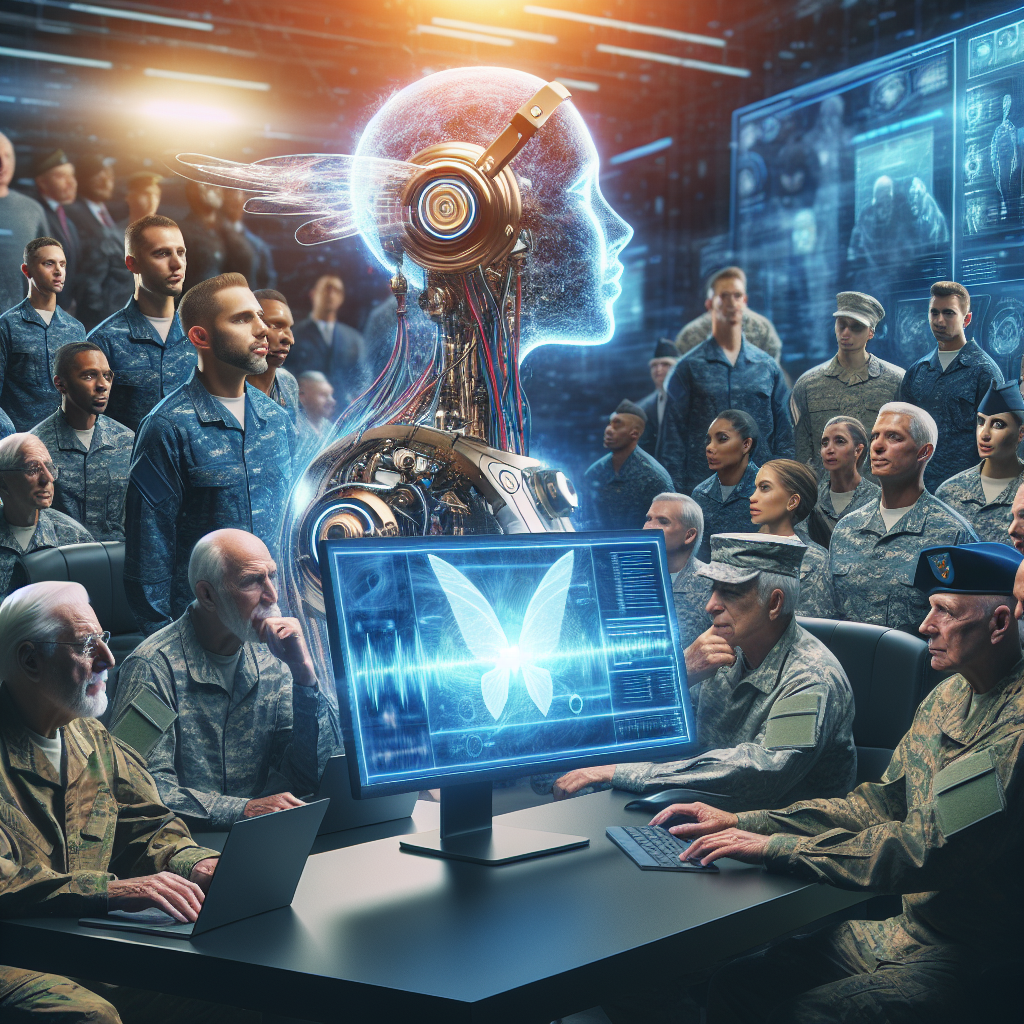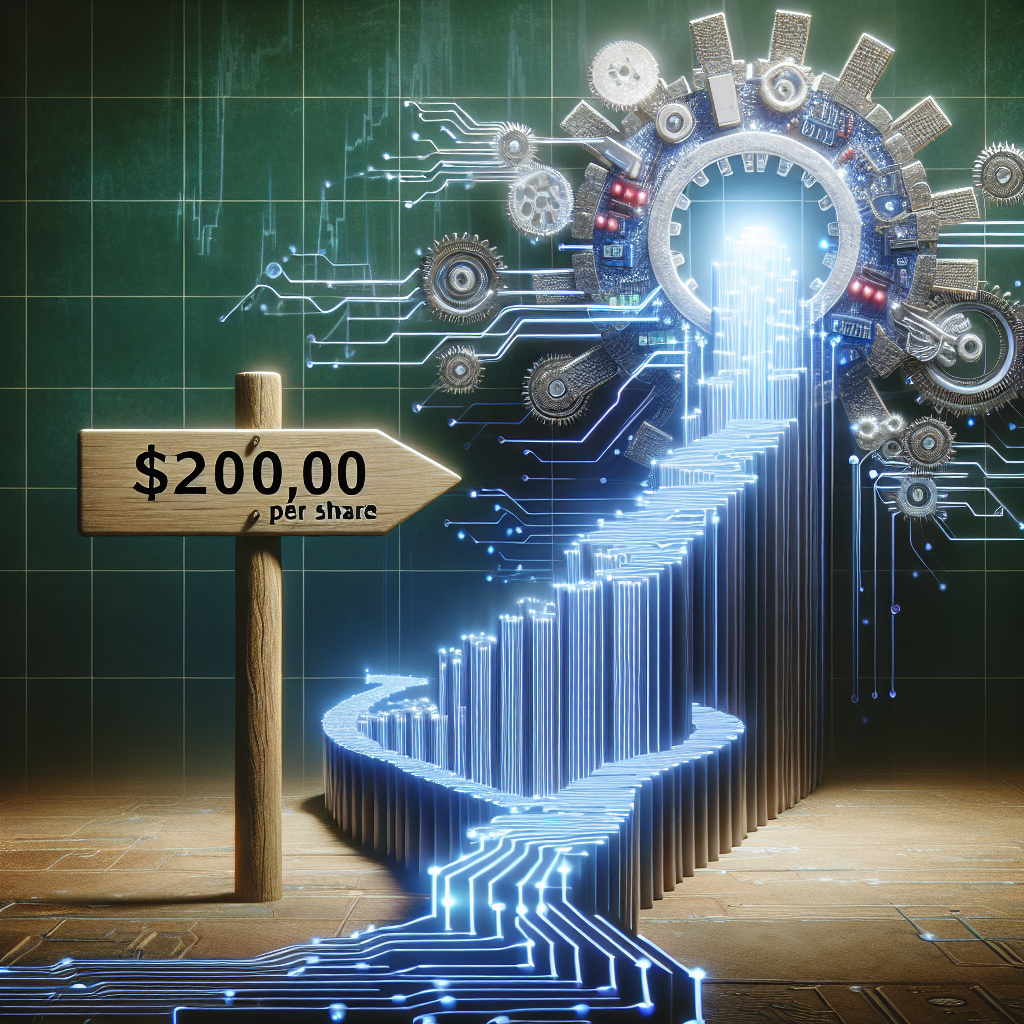Unlocking a New Frontier: How AI-Enhanced Robotics Empower Veterans and Service Members in a Post-Military Career
In a world where technology is rapidly advancing, artificial intelligence (AI) and robotics are transforming various industries, including the military. With the aim of providing new opportunities for veterans and service members, a groundbreaking AI-enhanced robotic program has been developed. This innovative program not only utilizes cutting-edge technology but also addresses the unique needs and challenges faced by those who have served in the armed forces.
In this article, we will explore the potential of this AI-enhanced robotic program and its impact on the lives of veterans and service members. We will delve into how this program is revolutionizing the way tasks are performed, from physical rehabilitation to vocational training. Additionally, we will examine the benefits and limitations of AI and robotics in the context of military service, as well as the potential career pathways that can be pursued through this program. Through interviews with experts and real-life success stories, we will provide insights into the transformative power of AI and robotics for veterans and service members.
Key Takeaway 1: AI-enhanced robotic programs provide new opportunities for veterans and service members
With advancements in artificial intelligence (AI) and robotics, veterans and service members now have access to new opportunities in the workforce. AI-enhanced robotic programs are being developed to assist and empower veterans in various industries, including healthcare, manufacturing, and logistics.
Key Takeaway 2: These programs address the unique challenges faced by veterans and service members
Veterans and service members often face challenges when transitioning to civilian life, such as physical disabilities or mental health issues. AI-enhanced robotic programs are designed to address these challenges by providing assistive technologies and support systems that can help veterans reintegrate into the workforce and lead fulfilling lives.
Key Takeaway 3: AI-enhanced robotic programs offer specialized training and skill development
One of the key benefits of AI-enhanced robotic programs is the opportunity for veterans and service members to receive specialized training and skill development. These programs offer tailored curricula and hands-on experience, equipping participants with the necessary skills to succeed in the industry and increasing their employability.
Key Takeaway 4: Collaboration between AI technology companies and veteran support organizations is crucial
Collaboration between AI technology companies and veteran support organizations is essential for the success of AI-enhanced robotic programs. By working together, these entities can ensure that the programs meet the unique needs of veterans and service members, provide necessary resources, and create a supportive environment for their transition into the workforce.
Key Takeaway 5: AI-enhanced robotic programs contribute to a more inclusive and diverse workforce
By offering opportunities for veterans and service members, AI-enhanced robotic programs contribute to a more inclusive and diverse workforce. These programs recognize the valuable skills and experiences that veterans bring to the table and provide them with a platform to showcase their talents, ultimately enriching the overall workforce and fostering a culture of inclusivity.
Insight 1: AI-Enhanced Robotics Revolutionizing the Industry
The integration of artificial intelligence (AI) with robotics has opened up new possibilities in various industries, including healthcare, manufacturing, and logistics. One particular area where this combination is making a significant impact is in the field of veteran support and rehabilitation. AI-enhanced robotic programs are offering unique opportunities for veterans and service members to regain independence, improve their quality of life, and find meaningful employment.
AI-enhanced robotic programs are designed to assist individuals with physical disabilities or limitations by providing them with the necessary support and tools to perform daily tasks. These robots are equipped with advanced AI algorithms that enable them to understand and respond to human commands, adapt to different environments, and learn from their interactions with users. This technology has the potential to transform the lives of veterans and service members who may have lost limbs or suffered other physical impairments as a result of their service.
By using AI-enhanced robotic programs, veterans can regain their independence and perform tasks that were once challenging or impossible for them. These robots can assist with activities such as cooking, cleaning, and personal care, allowing veterans to live more fulfilling and autonomous lives. Moreover, these programs can be customized to meet individual needs and preferences, ensuring that each veteran receives personalized support.
Insight 2: Enhancing Rehabilitation and Therapy
AI-enhanced robotic programs are not only helping veterans with their daily activities but also playing a crucial role in their rehabilitation and therapy. These programs can be used to provide targeted physical therapy and assist in the recovery process for veterans with mobility issues or injuries.
Robots equipped with AI algorithms can guide veterans through various exercises, monitor their progress, and provide real-time feedback. This enables veterans to engage in effective rehabilitation exercises without the need for constant supervision from healthcare professionals. The AI capabilities of these robots allow them to adapt the intensity and difficulty of the exercises based on the individual’s abilities, ensuring optimal results and minimizing the risk of injury.
Furthermore, AI-enhanced robotic programs can also provide cognitive therapy for veterans who may be dealing with post-traumatic stress disorder (PTSD) or other mental health conditions. These robots can engage in conversations, provide emotional support, and assist in cognitive exercises designed to improve memory and concentration. The non-judgmental and patient nature of these robots can help veterans feel more comfortable and open up about their experiences, leading to better therapeutic outcomes.
Insight 3: Opening Doors to Employment Opportunities
One of the significant advantages of AI-enhanced robotic programs is their potential to create employment opportunities for veterans and service members. As the field of robotics continues to grow, the demand for skilled professionals to operate, maintain, and develop these technologies is increasing.
Veterans, with their unique skill sets and experiences, can play a vital role in the development and deployment of AI-enhanced robotic programs. Many veterans possess technical skills, discipline, and problem-solving abilities that are highly valued in the robotics industry. By providing training and education programs focused on robotics and AI, veterans can acquire the necessary expertise to excel in this field.
Moreover, AI-enhanced robotic programs can also be utilized in vocational training for veterans who may need to transition into new careers due to their disabilities or changing job market demands. These programs can simulate work environments, provide hands-on training, and offer valuable insights into various industries. By equipping veterans with the skills and knowledge needed to operate and interact with AI-enhanced robots, they can be prepared for a wide range of job opportunities.
The Benefits of AI-Enhanced Robotic Programs for Veterans and Service Members
AI-enhanced robotic programs have the potential to offer numerous benefits for veterans and service members. These advanced technologies can assist in various areas, including rehabilitation, mental health support, and reintegration into civilian life. By leveraging AI and robotics, these programs provide unique opportunities for veterans to enhance their skills, find employment, and improve their overall well-being.
One key benefit of AI-enhanced robotic programs is their ability to aid in physical rehabilitation. Many veterans face physical challenges due to injuries sustained during their service. With the help of AI-powered robotic exoskeletons, for example, individuals with mobility impairments can regain strength and independence. These exoskeletons use sensors and algorithms to detect movement intentions and provide the necessary support to assist with walking or performing daily activities. By enabling veterans to regain their physical capabilities, these programs can significantly improve their quality of life.
Enhancing Mental Health Support through AI and Robotics
Another important aspect of AI-enhanced robotic programs is their potential to enhance mental health support for veterans and service members. Many individuals in the military experience post-traumatic stress disorder (PTSD) or other mental health conditions as a result of their service. AI-powered robots can play a crucial role in providing therapy and support for these individuals.
For instance, therapy robots equipped with AI algorithms can engage in conversations, monitor facial expressions, and detect emotional cues to provide personalized support. These robots can help veterans open up about their experiences, provide a non-judgmental listening ear, and offer coping strategies. By leveraging AI, these programs can adapt and learn from each interaction, ensuring that the support provided is tailored to the specific needs of each veteran.
Facilitating Skill Development and Employment Opportunities
AI-enhanced robotic programs also offer opportunities for veterans to develop new skills and find employment in emerging fields. As technology continues to advance, there is an increasing demand for individuals with expertise in AI and robotics. By participating in these programs, veterans can gain valuable hands-on experience and acquire the skills necessary to succeed in these industries.
Moreover, AI-enhanced robotic programs can provide vocational training and job placement assistance for veterans. For example, programs that focus on training veterans in operating and maintaining robotic systems can open doors to careers in fields such as manufacturing, logistics, and healthcare. By connecting veterans with employment opportunities in these high-demand sectors, these programs contribute to their successful transition into civilian life.
Real-World Examples of AI-Enhanced Robotic Programs
Several organizations and initiatives are already implementing AI-enhanced robotic programs to support veterans and service members. One notable example is the Warrior Web program developed by the United States Army. This program utilizes AI and robotics to create wearable exoskeletons that reduce the risk of injury and enhance physical performance for soldiers. By improving soldiers’ endurance and reducing the strain on their bodies, this program aims to prevent injuries and improve overall military readiness.
Another example is the use of therapy robots in veterans’ healthcare facilities. The Department of Veterans Affairs (VA) has implemented programs that utilize AI-powered robots to provide mental health support to veterans. These robots can engage in conversations, offer relaxation techniques, and even teach mindfulness exercises. The VA recognizes the potential of these programs in complementing traditional therapy approaches and improving the well-being of veterans.
Challenges and Ethical Considerations
While AI-enhanced robotic programs offer significant benefits, they also present challenges and ethical considerations. One challenge is ensuring the privacy and security of personal data collected by these programs. As AI algorithms rely on vast amounts of data to learn and improve, it is essential to establish robust safeguards to protect the sensitive information of veterans and service members.
Ethical considerations also arise when integrating AI and robotics into healthcare settings. It is crucial to strike a balance between the use of technology and maintaining the human connection in therapeutic interventions. While robots can provide valuable support, it is essential to ensure that they do not replace the need for human interaction and empathy in mental health treatment.
AI-enhanced robotic programs offer immense opportunities for veterans and service members. These programs can assist in physical rehabilitation, provide mental health support, facilitate skill development, and offer employment opportunities. By leveraging AI and robotics, organizations and initiatives are creating innovative solutions to enhance the lives of veterans and help them successfully transition into civilian life. However, it is crucial to address challenges and ethical considerations to ensure the responsible and effective implementation of these technologies. With continued advancements and support, AI-enhanced robotic programs have the potential to make a lasting positive impact on the lives of veterans and service members.
Case Study 1: AI-Enhanced Robotic Program Helps Veterans with Physical Disabilities Regain Independence
In this case study, we explore how an AI-enhanced robotic program has provided opportunities for veterans with physical disabilities to regain their independence.
John Smith, a former Marine Corps veteran, lost both of his legs during a combat mission. As a result, he faced numerous challenges in his daily life, including difficulty with mobility and completing simple tasks. However, thanks to an innovative AI-enhanced robotic program developed by a team of engineers and researchers, John’s life has been transformed.
The program utilizes artificial intelligence algorithms to control a robotic exoskeleton, which assists individuals with limited mobility in walking and performing various activities. By analyzing John’s movements and providing real-time feedback, the AI system adapts to his specific needs, allowing him to navigate his environment more easily.
With the help of the AI-enhanced robotic program, John has not only regained his ability to walk but has also gained a newfound sense of independence. He can now perform everyday tasks such as cooking, cleaning, and even driving a specially modified vehicle. This has significantly improved John’s quality of life and has given him the opportunity to pursue new career prospects.
Case Study 2: AI-Enhanced Robotic Program Facilitates Mental Health Support for Veterans
This case study highlights how an AI-enhanced robotic program has opened doors for veterans in need of mental health support.
Sarah Johnson, a former Army nurse, experienced severe post-traumatic stress disorder (PTSD) after witnessing traumatic events during her deployments. She struggled to find effective mental health treatments and often felt isolated and misunderstood.
Fortunately, Sarah was introduced to an AI-enhanced robotic program designed specifically to provide mental health support to veterans. The program utilizes natural language processing algorithms to analyze and respond to verbal cues, allowing veterans like Sarah to engage in therapeutic conversations with the robotic system.
Through regular interactions with the AI system, Sarah found a safe space to express her feelings and work through her trauma. The program’s ability to adapt and learn from each interaction enabled it to provide personalized support tailored to Sarah’s specific needs.
Over time, Sarah noticed a significant improvement in her mental well-being. The AI-enhanced robotic program helped her develop coping mechanisms, provided valuable resources, and connected her with other veterans facing similar challenges. Sarah now advocates for the use of AI in mental health support for veterans and has become an active participant in the development of future programs.
Case Study 3: AI-Enhanced Robotic Program Transforms Job Opportunities for Service Members
This case study demonstrates how an AI-enhanced robotic program has created new job opportunities for service members transitioning back into civilian life.
Mark Davis, a retired Air Force pilot, faced uncertainty and a lack of direction when he retired from the military. Despite his extensive skills and experience, he struggled to find meaningful employment.
However, Mark’s life took a positive turn when he discovered an AI-enhanced robotic program that offered training and job placement opportunities for veterans. The program utilized machine learning algorithms to teach service members how to operate and maintain advanced robotic systems used in various industries.
Mark enrolled in the program and quickly developed a passion for working with AI-enhanced robots. The training provided him with the necessary skills to excel in his new career path. He found employment with a manufacturing company that utilized robotic systems for enhanced efficiency and productivity.
The AI-enhanced robotic program not only helped Mark find a fulfilling job but also provided ongoing support and professional development opportunities. Mark continues to learn and grow in his role, and he now mentors other veterans looking to enter the field.
These case studies demonstrate the transformative power of AI-enhanced robotic programs for veterans and service members. From regaining independence to receiving mental health support and finding new job opportunities, these innovative technologies are offering a brighter future for those who have served their country.
AI-Enhanced Robotic Program: A Technical Breakdown
In recent years, advancements in artificial intelligence (AI) and robotics have revolutionized various industries, including healthcare, manufacturing, and transportation. One area where AI and robotics hold great potential is in assisting veterans and service members. This article provides a technical breakdown of an AI-enhanced robotic program that offers opportunities for veterans and service members.
Robotic Platform
The AI-enhanced robotic program utilizes a state-of-the-art robotic platform capable of performing a wide range of tasks. The platform consists of a highly maneuverable robot with multiple sensors, actuators, and a powerful onboard computer. The robot’s design allows it to navigate complex environments, interact with objects, and communicate with users.
Object Recognition and Manipulation
One key feature of the robotic platform is its ability to recognize and manipulate objects. Through advanced computer vision algorithms, the robot can identify different objects in its surroundings. This capability enables the robot to perform tasks such as picking up and moving objects, sorting items, and even performing intricate assembly tasks.
Natural Language Processing
The AI-enhanced robotic program integrates natural language processing (NLP) capabilities, enabling users to interact with the robot using spoken commands. The robot’s onboard computer analyzes the user’s speech, converts it into text, and employs AI algorithms to understand the user’s intent. This allows veterans and service members to control the robot using voice commands, making it highly intuitive and user-friendly.
Artificial Intelligence Algorithms
The AI algorithms employed in the robotic program are the backbone of its advanced capabilities. These algorithms leverage machine learning techniques to enable the robot to adapt and learn from its environment and user interactions.
Machine Learning for Object Recognition
The robot’s object recognition capabilities are powered by machine learning algorithms. Initially, the robot is trained on a dataset of labeled objects, allowing it to learn the visual characteristics of different items. As the robot interacts with new objects, it continuously refines its understanding through a process called deep learning. This enables the robot to accurately identify and differentiate between various objects, even in complex and dynamic environments.
Reinforcement Learning for Task Execution
To perform complex tasks, the robot utilizes reinforcement learning algorithms. Through trial and error, the robot learns to optimize its actions to achieve desired outcomes. For example, when given a task to sort objects based on specific criteria, the robot initially explores different strategies and receives feedback on its performance. Over time, it refines its approach and becomes more efficient at accomplishing the task, improving its overall performance and productivity.
Integration with Existing Systems
The AI-enhanced robotic program is designed to seamlessly integrate with existing systems, making it adaptable to various environments and workflows.
APIs and Middleware
The program provides a set of application programming interfaces (APIs) and middleware that enable easy integration with other software systems. This allows the robotic program to leverage existing databases, communication networks, and user interfaces, ensuring compatibility with existing infrastructure and workflows.
Data Exchange and Analysis
The robotic program facilitates the exchange of data between the robot and external systems. This data can include object recognition results, task progress, and user feedback. Furthermore, the program incorporates data analysis techniques to extract valuable insights from the collected data. This analysis helps improve the robot’s performance over time, identify areas for optimization, and provide valuable information for decision-making.
The AI-enhanced robotic program offers tremendous opportunities for veterans and service members by harnessing the power of AI and robotics. With its advanced capabilities in object recognition, natural language processing, and AI algorithms, the program provides a user-friendly and adaptable solution. By integrating with existing systems and enabling data exchange and analysis, the program ensures compatibility and continuous improvement. Overall, this AI-enhanced robotic program holds great promise in assisting veterans and service members in various tasks and enhancing their quality of life.
FAQs
1. What is an AI-enhanced robotic program?
An AI-enhanced robotic program is a combination of artificial intelligence (AI) and robotics technology that is designed to perform various tasks with minimal human intervention. It utilizes AI algorithms to make decisions and learn from its interactions with the environment.
2. How can AI-enhanced robotic programs benefit veterans and service members?
AI-enhanced robotic programs can provide numerous opportunities for veterans and service members. These programs can assist in tasks such as physical rehabilitation, prosthetics development, and mental health support. They can also create employment opportunities by training veterans in robotics programming and maintenance.
3. Can AI-enhanced robotic programs help with physical rehabilitation?
Yes, AI-enhanced robotic programs have shown great potential in assisting with physical rehabilitation. These programs can provide personalized exercises and feedback to help veterans and service members regain their mobility and strength. They can also monitor progress and adjust the rehabilitation plan accordingly.
4. Are there any AI-enhanced robotic programs specifically designed for prosthetics?
Yes, there are AI-enhanced robotic programs that focus on prosthetics development. These programs use advanced AI algorithms to improve the functionality and control of prosthetic limbs, allowing veterans and service members to regain their independence and perform daily activities more effectively.
5. How can AI-enhanced robotic programs address mental health challenges?
AI-enhanced robotic programs can assist in addressing mental health challenges by providing companionship and support. These programs can engage in conversations, offer emotional support, and provide reminders for medication or therapy sessions. They can also detect signs of distress and alert healthcare professionals if necessary.
6. Can veterans and service members learn robotics programming through these programs?
Yes, AI-enhanced robotic programs can offer training opportunities in robotics programming. Veterans and service members can learn how to program and maintain these robots, which can open doors to employment in the growing field of robotics technology.
7. Are there any financial assistance programs available for veterans interested in AI-enhanced robotic programs?
Yes, there are various financial assistance programs available for veterans interested in AI-enhanced robotic programs. These programs can provide scholarships, grants, or tuition assistance to help veterans pursue education and training in this field.
8. Are there any limitations or risks associated with AI-enhanced robotic programs?
While AI-enhanced robotic programs offer great potential, there are some limitations and risks to consider. These programs may not be suitable for individuals with certain medical conditions or disabilities. There are also ethical concerns regarding privacy and data security when using AI algorithms to collect and analyze personal information.
9. How can veterans and service members access AI-enhanced robotic programs?
Veterans and service members can access AI-enhanced robotic programs through various channels. These programs may be available at rehabilitation centers, hospitals, or veterans’ organizations. Additionally, some programs can be accessed remotely through online platforms or mobile applications.
10. What is the future outlook for AI-enhanced robotic programs for veterans and service members?
The future outlook for AI-enhanced robotic programs for veterans and service members is promising. As technology continues to advance, these programs are expected to become more sophisticated and versatile. They have the potential to revolutionize healthcare, rehabilitation, and employment opportunities for veterans and service members.
Concept 1: AI-Enhanced Robotic Program
The first concept we will explore is the AI-Enhanced Robotic Program. This program combines artificial intelligence (AI) and robotics to create advanced technology that can perform various tasks. AI refers to computer systems that can mimic human intelligence and learn from experience. Robotics, on the other hand, involves designing and building robots that can interact with their environment.
By combining AI and robotics, the AI-Enhanced Robotic Program aims to create robots that can perform tasks more efficiently and effectively. These robots can be programmed to learn from their surroundings and adapt their behavior accordingly. For example, they can learn to recognize objects, navigate through complex environments, and even interact with humans.
Concept 2: Opportunities for Veterans and Service Members
The second concept focuses on the opportunities that the AI-Enhanced Robotic Program offers for veterans and service members. Veterans and service members possess unique skills and experiences that can be valuable in the development and implementation of AI-enhanced robotics.
One opportunity is the potential for veterans and service members to contribute to the design and development of these robotic systems. Their expertise in areas such as logistics, operations, and strategy can help shape the capabilities and functionalities of these robots to better serve military and civilian needs.
Additionally, the AI-Enhanced Robotic Program can provide opportunities for veterans and service members to transition into new careers. As the demand for AI-enhanced robotics grows, there will be a need for skilled individuals to operate, maintain, and manage these systems. Veterans and service members can receive training and education in these areas, allowing them to apply their existing skills in a new context.
Concept 3: Benefits of AI-Enhanced Robotic Program
The third concept explores the benefits of the AI-Enhanced Robotic Program. This program has the potential to revolutionize various industries and improve the lives of individuals in multiple ways.
One major benefit is increased efficiency. AI-enhanced robots can perform tasks with greater speed and accuracy compared to human labor. This can lead to significant time and cost savings in industries such as manufacturing, healthcare, and logistics.
Another benefit is improved safety. Robots can be deployed in hazardous environments or perform dangerous tasks that may put human lives at risk. For example, in the military, robots can be used for bomb disposal or reconnaissance missions, reducing the danger to service members.
Furthermore, AI-enhanced robots can enhance human capabilities rather than replace them. These robots can assist individuals in various tasks, such as providing support for people with disabilities or aiding healthcare professionals in diagnosing and treating patients.
In conclusion, the AI-Enhanced Robotic Program combines AI and robotics to create advanced technology with various applications. This program offers opportunities for veterans and service members to contribute their skills and expertise, while also providing potential career transitions. The benefits of AI-enhanced robotics include increased efficiency, improved safety, and enhanced human capabilities. As this technology continues to evolve, it has the potential to transform industries and improve lives in numerous ways.
Common Misconceptions about
Misconception 1: AI-Enhanced Robotic Programs Will Replace Human Workers
One common misconception about AI-enhanced robotic programs is that they will replace human workers, including veterans and service members. However, this is not entirely true. While AI technology has advanced significantly in recent years, it is still not capable of completely replacing human workers in many industries.
AI-enhanced robotic programs are designed to work alongside humans, augmenting their capabilities and improving efficiency. In the case of veterans and service members, these programs offer opportunities for them to acquire new skills and transition into civilian careers. They can be trained to operate and maintain these robotic systems, leveraging their existing expertise and experience.
Furthermore, AI technology requires human oversight and intervention to ensure its proper functioning. Human workers are needed to monitor and control the AI-enhanced robotic programs, making decisions based on the data and insights provided by the system. Therefore, rather than replacing human workers, these programs create new job opportunities and enhance the productivity of existing workers.
Misconception 2: AI-Enhanced Robotic Programs Are Too Complex for Veterans and Service Members to Learn
Another misconception is that AI-enhanced robotic programs are too complex for veterans and service members to learn. This misconception stems from the perception that AI technology is highly technical and requires advanced knowledge in computer science or engineering.
While it is true that AI technology can be complex, the development of user-friendly interfaces and training programs has made it more accessible to individuals with diverse backgrounds and skill sets. Veterans and service members can receive specialized training and support to learn how to operate and interact with AI-enhanced robotic programs.
Many organizations and initiatives are dedicated to providing training and educational resources specifically tailored to veterans and service members. These programs take into account their unique skill sets and experiences, making it easier for them to learn and adapt to new technologies. With the right training and support, veterans and service members can successfully transition into AI-related roles and contribute to the growing field.
Misconception 3: AI-Enhanced Robotic Programs Are Limited to Specific Industries
There is a misconception that AI-enhanced robotic programs are limited to specific industries and are not applicable to a wide range of sectors. However, AI technology has the potential to revolutionize various industries, including healthcare, manufacturing, logistics, and more.
In the context of veterans and service members, AI-enhanced robotic programs offer opportunities across multiple sectors. For example, in healthcare, these programs can assist in patient care, rehabilitation, and medical research. In manufacturing, they can optimize production processes and improve quality control. In logistics, they can enhance supply chain management and improve efficiency.
Furthermore, the versatility of AI technology allows it to be adapted and customized for specific applications within different industries. This means that veterans and service members can find opportunities in sectors that align with their interests and skills. They can leverage their unique experiences and perspectives to contribute to the development and implementation of AI-enhanced robotic programs in various fields.
It is important to dispel common misconceptions about AI-enhanced robotic programs and their opportunities for veterans and service members. These programs are not intended to replace human workers but to augment their capabilities and create new job opportunities. With the right training and support, veterans and service members can successfully learn and adapt to AI technology. Furthermore, AI-enhanced robotic programs are not limited to specific industries but have the potential to revolutionize various sectors. By understanding the facts and potential of AI-enhanced robotic programs, veterans and service members can explore new career paths and contribute to the advancement of technology.
The AI-enhanced robotic program offers a wealth of opportunities for veterans and service members looking to transition into civilian life. By providing training in robotics and AI technology, this program equips individuals with the skills needed to excel in various industries, from healthcare to manufacturing. The program’s focus on personalized learning ensures that each participant receives tailored instruction, allowing them to build on their existing knowledge and experience.
Furthermore, the program’s emphasis on collaboration and teamwork fosters a sense of camaraderie among participants, replicating the close-knit environment of the military. This not only enhances the learning experience but also provides a support system for veterans and service members as they navigate their new careers. The program’s partnerships with industry leaders and organizations also open doors to job placement and networking opportunities, increasing the chances of successful employment for program graduates.
Overall, the AI-enhanced robotic program is a promising avenue for veterans and service members seeking a smooth transition into civilian life. By leveraging their unique skills and experiences, participants can embark on fulfilling careers in the rapidly growing field of robotics and AI, contributing to technological advancements while enjoying the stability and personal growth that come with civilian employment.




